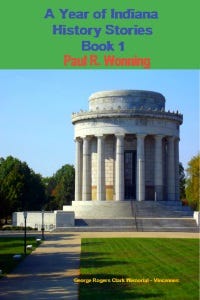February 16, 1852 - Henry and Clement Studebaker Open Blacksmith Shop - South Bend
The Beginnings of Studebaker Automobile
Thanks for reading A Potpourri of History, Travel and Gardening ! Subscribe for free to receive new posts and support my work.
Two of the five sons of John C. Studebaker migrated from their home in Ashland, Ohio to South Bend, Indiana. Clement and Henry's total assets consisted of sixty-eight dollars and two sets of blacksmith tools. They also had their father John's advice, "Always give more than you promise."
John C. Studebaker (1833-1917)
John was a blacksmith and wagon maker in Gettysburg, Pennsylvania. He and his wife Rebecca Mohler Studebaker had ten children, five sons and five daughters. John proved an excellent blacksmith and wagon maker, but poor businessman. He found himself far in debt because he extended too much credit for too long to his customers. His sons all learned his trade before he was forced to sell his business, build a Conestoga wagon and flee to Ashland, Ohio. His debtors caught up with him and again he moved the family in the same Conestoga wagon. This time he landed in South Bend, Indiana.
H&C Studebaker
The brothers Henry and Clement set up their shop in South Bend and enjoyed limited success at the beginning. A third brother, John Mohler, or JM, migrated by wagon train to California in 1852. He had gone to the gold fields to seek his fortune there, like hundreds of other men. Upon arrival, he had fifty cents in his pocket. His intention was to manufacture wagons, however a local blacksmith persuaded him to build wheelbarrows, instead. He took the advice and his wheelbarrows were a success. Pocketing over $8,000 in profits JM returned to South Bend via Panama. The trip persuaded him that the future lay in transportation and he returned to South Bend to invest in his brother's blacksmith and wagon making business. Brother Peter decided to open a wagon distribution business in Goshen, Indiana, giving the brothers another outlet for their wagons. With JM's capital, the brothers began making wagons without waiting for orders from customers. Business began to boom.
Business Expands
When the Civil War began, the company profited from government contracts to build wagons. By 1865, the brothers expanded their range, opening major branch offices in other cities across the state and country. They competed successfully with other wagon manufacturers by using superior workmanship and materials. Their satisfied customer base continued to grow. By 1868, the business had grown to 190 loyal employees. They produced 3,955 that year and their assets had grown from $68 to over $200,000.
This story excerpted from the author's book:
A Year of Indiana History Stories - Book 1
A Year of Indiana History Stories Book 1 includes three hundred and sixty-six stories of Indiana history. Written in a this day in history format, this journal is ideal for kids and adults alike.
#mossyfeetbooks #indianahistory




